Imagine the anticipation of sizzling bacon or searing a perfectly seasoned steak in your trusty cast iron pan, only to find it frustratingly sticky instead of flawlessly non-stick. It’s a culinary conundrum that has left many home cooks scratching their heads and wondering, “Why is my cast iron pan sticky after seasoning?” In the realm of kitchen mysteries, this sticky situation ranks high, but fear not, as we embark on a journey to unravel the secrets behind this enigmatic occurrence and restore your cast iron pan to its rightful glory as the undisputed king of cookware.
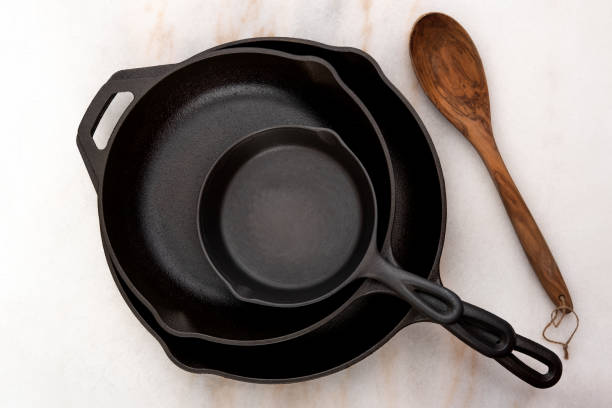
What Is A Cast-Iron Pan?
A cast-iron pan is a timeless culinary tool revered for its durability, versatility, and ability to impart unparalleled flavor to dishes. Crafted from molten iron poured into molds, these pans boast a rugged, non-stick surface that improves with age and seasoning.
Their thick construction ensures even heat distribution, making them ideal for searing meats, frying, baking, and even outdoor cooking over open flames. Beyond functionality, a well-seasoned cast-iron pan develops a distinct patina, a glossy layer that not only enhances its non-stick properties but also adds depth to the flavor of foods cooked within it.
This seasoning, a result of oils bonding with the iron surface over time, creates a natural barrier against rust and corrosion, further enhancing the pan’s longevity.
From crispy-skinned chicken to perfectly charred vegetables, the cast-iron pan promises culinary excellence while embodying a rich culinary heritage passed down through generations.
Its rustic charm and unparalleled performance make it a staple in kitchens worldwide, cherished by home cooks and professional chefs alike.
Types of cast iron pan
1. Coated Cast Iron Pan
Pros:
- Non-stick surface: Coated cast iron pans often come with enamel or porcelain coatings, providing a naturally non-stick cooking surface without the need for extensive seasoning.
- Easy to clean: The smooth enamel coating makes cleaning easier compared to uncoated cast iron, as food residues are less likely to stick to the surface.
- Versatile colors: Coated cast iron pans come in a variety of colors, allowing for personalization and aesthetic integration into kitchen decor.
- Resistant to acidic foods: The enamel coating provides protection against acidic foods, preventing reactions that can occur with uncoated cast iron.
Cons:
- Limited heat retention: The enamel coating can hinder the pan’s ability to retain heat as effectively as uncoated cast iron, potentially impacting searing and browning capabilities.
- Prone to chipping: Enamel coatings can chip or crack over time, especially with rough handling or exposure to extreme temperature changes, compromising the pan’s durability.
- Not suitable for high heat: Coated cast iron pans may not withstand high heat as well as uncoated versions, limiting their use for certain cooking techniques like broiling or outdoor grilling.
2. Uncoated Cast Iron Pan
Pros:
- Excellent heat retention: Uncoated cast iron pans excel at retaining and distributing heat evenly, making them ideal for tasks like searing, frying, and baking.
- Naturally non-stick when seasoned: With proper seasoning, uncoated cast iron develops a natural non-stick surface that improves with each use, providing superior release properties over time.
- Durable: Uncoated cast iron pans are highly durable and resistant to scratching and chipping, ensuring longevity even with regular use.
- Versatile: Uncoated cast iron pans can be used on various heat sources, including stovetops, ovens, grills, and even campfires, making them versatile tools for indoor and outdoor cooking.
Cons:
- Requires seasoning and maintenance: Uncoated cast iron pans need to be seasoned regularly to maintain their non-stick properties and prevent rusting, which can be time-consuming for some users.
- Reactive to acidic foods: Uncoated cast iron can react with acidic ingredients, potentially imparting a metallic taste to foods and causing discoloration or rusting if not properly cared for.
- Susceptible to rust: Without proper seasoning and maintenance, uncoated cast iron pans are prone to rusting, especially if exposed to moisture or acidic foods for extended periods. Regular seasoning and thorough drying are essential to prevent rust formation.
What Is Seasoning?
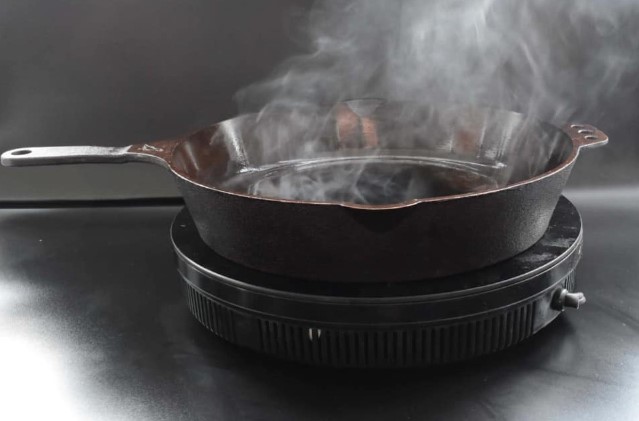
Seasoning, in the context of cast iron cookware, refers to the process of creating a natural, non-stick surface on the pan by polymerizing oil onto its surface.
This process involves coating the cast iron with a thin layer of cooking oil or fat and then heating it to a specific temperature, typically around 350°F to 400°F (175°C to 200°C). As the oil heats, it undergoes a chemical reaction known as polymerization, forming a layer of seasoning that bonds with the iron surface.
This layer not only provides a non-stick surface for cooking but also helps to protect the cast iron from rust and corrosion. Seasoning is a crucial step in maintaining and prolonging the life of cast iron cookware, as it improves its performance over time and with continued use.
Regularly seasoning your cast iron pan helps to build up layers of seasoning, resulting in a smoother and more durable cooking surface. Proper seasoning can enhance the flavor of foods cooked in cast iron, adding depth and richness to dishes.
5 Reasons Why Your Cast Iron Pan Is Sticky Even After Seasoning
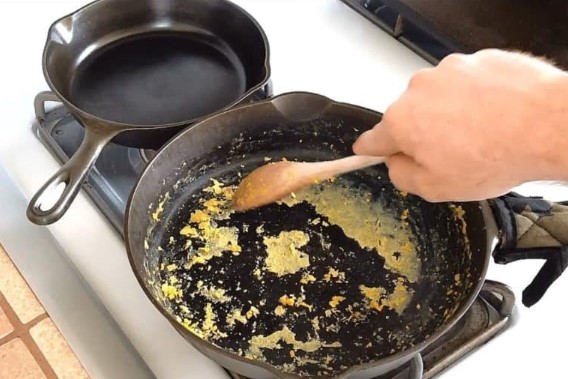
Not Enough Oil Or Fat
One of the primary reasons your cast iron pan may remain sticky even after seasoning is the application of too little oil or fat during the seasoning process.
Proper seasoning requires a sufficient amount of oil or fat to be applied to the pan’s surface to create a polymerized layer that acts as a non-stick coating. If there isn’t enough oil or fat applied, the seasoning may not form properly, leaving the surface sticky instead of smooth and non-stick.
To remedy this, ensure you’re applying an adequate amount of oil or fat to the pan, evenly coating all surfaces, and allowing it to polymerize through heating. Consider repeating the seasoning process with a slightly heavier application of oil to build up the seasoning layers and achieve the desired non-stick surface.
Using Either Too Much Oil Or The Wrong Choice Of Cooking Oil
Using either too much oil or the wrong choice of cooking oil can indeed result in a sticky cast iron pan, even after seasoning. Here’s how:
- Excessive Oil: Applying too much oil during the seasoning process can lead to a sticky residue on the pan’s surface. When too much oil is used, it can pool and become gummy when heated. Instead of forming a smooth, polymerized layer, the excess oil may remain tacky and fail to properly bond with the cast iron.
- Wrong Choice of Cooking Oil: Not all oils are suitable for seasoning cast iron pans. Oils with low smoke points or high levels of polyunsaturated fats, such as extra virgin olive oil, are not ideal for seasoning as they can polymerize incompletely and leave a sticky residue. It’s best to use oils with high smoke points and stable fat compositions, such as vegetable oil, canola oil, or flaxseed oil, for seasoning cast iron.
To address these issues, ensure you’re using the correct amount of oil – just enough to thinly coat the pan’s surface – and choose an appropriate oil with a high smoke point and stable fat composition. Consider reseasoning the pan with the correct amount and type of oil to build up a proper non-stick coating and eliminate stickiness.
Overcooked Food Residue
Overcooked food residue can contribute to a sticky cast iron pan, even after seasoning. When food is overcooked or burnt onto the surface of the pan, it can create a stubborn layer that is difficult to remove, leading to stickiness. This residue may not only interfere with the non-stick properties of the seasoning but also contribute to a rough, uneven cooking surface. To address this issue, it’s essential to properly clean the cast iron pan after each use. Here’s how to remove overcooked food residue and restore the pan’s non-stick properties:
- Scrub with hot water and a brush: After cooking, allow the pan to cool slightly but not completely. Then, use hot water and a stiff-bristled brush or scraper to scrub away any stuck-on food residue. Avoid using soap, as it can strip away the seasoning layer.
- Boil water in the pan: If the residue is particularly stubborn, fill the pan with water and bring it to a boil. Allow it to simmer for a few minutes to loosen the food particles, then scrub the surface again.
- Use kosher salt as an abrasive: For tough residue, sprinkle kosher salt onto the surface of the pan and use a paper towel or cloth to scrub in a circular motion. The salt acts as a gentle abrasive to help lift off the stuck-on food.
- Re-season the pan: Once the residue is removed, dry the pan thoroughly with a clean towel or by heating it on the stove over low heat. Then, apply a thin layer of oil to the entire surface of the pan, including the cooking surface and exterior, and heat it in the oven or on the stovetop until the oil polymerizes and forms a new seasoning layer.
By properly cleaning and re-seasoning the cast iron pan, you can remove overcooked food residue and restore its non-stick properties, preventing stickiness in the future.
Pan Temperature: Either Too Cold Or Too Hot
Pan temperature is indeed crucial when cooking with cast iron, and extremes of either too cold or too hot can contribute to stickiness. Here’s how:
- Too Cold: If the cast iron pan is not preheated properly before adding food, it can result in sticking. When the pan is too cold, food tends to absorb oil rather than forming a non-stick barrier. As a result, proteins in the food may stick to the surface, leading to difficulties in flipping or releasing food. To remedy this, ensure your cast iron pan is preheated adequately over medium to medium-high heat before adding ingredients.
- Too Hot: On the other hand, if the pan becomes too hot, especially without any oil or fat, it can cause food to burn and stick to the surface. Additionally, overheating can damage the existing seasoning layer, making the pan more prone to stickiness. It’s essential to monitor the heat and adjust accordingly to prevent overheating. If the pan becomes too hot, you can reduce the heat or remove it from the heat source briefly to allow it to cool down slightly before continuing cooking.
To find the right temperature for cooking with cast iron, it often requires a bit of practice and adjustment based on your specific stove and cooking environment. Starting with a moderate heat level and gradually adjusting as needed can help achieve the optimal cooking temperature for your cast iron pan, reducing the likelihood of stickiness and ensuring excellent cooking results.
Frequent Seasoning On A Stovetop Instead Of An Oven
Frequent seasoning on a stovetop instead of an oven may contribute to stickiness in a cast iron pan. Here’s why:
- Uneven Heat Distribution: Seasoning on a stovetop can lead to uneven heat distribution across the pan’s surface. Unlike an oven, which provides consistent heat from all sides, a stovetop may not evenly distribute heat, causing some areas of the pan to season more than others. This inconsistency can result in uneven polymerization of the oil, leading to patchy or sticky areas on the pan.
- Limited Space and Ventilation: Stovetops typically have limited space compared to ovens, which can make it challenging to season multiple pans simultaneously or provide adequate ventilation. Without proper airflow, the seasoning process may not be as effective, leading to stickiness or incomplete polymerization of the oil.
- Higher Risk of Overheating: Seasoning on a stovetop also poses a higher risk of overheating the pan, especially if the heat is not carefully monitored. Overheating can cause the oil to break down or burn, resulting in a sticky residue on the pan’s surface rather than a smooth, non-stick coating.
To avoid stickiness and achieve optimal seasoning results, it’s recommended to use an oven for seasoning cast iron pans. This allows for more even heat distribution, better ventilation, and reduced risk of overheating. Additionally, following proper seasoning techniques, such as applying a thin layer of oil, heating the pan to the appropriate temperature, and allowing sufficient time for polymerization, can help ensure a non-stick surface and prevent stickiness in cast iron pans.
How To Properly Season A Cast-Iron Pan?
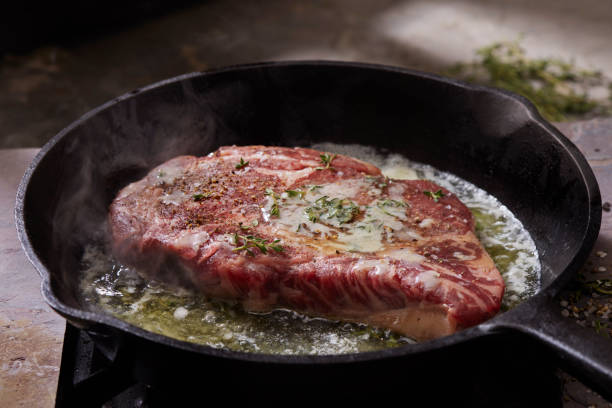
Properly seasoning a cast-iron pan is essential for creating a non-stick surface and preventing stickiness. Here’s a step-by-step guide to seasoning your cast-iron pan:
1. Clean the Pan
Start by washing the cast-iron pan with hot water and a small amount of mild dish soap to remove any dirt, residue, or factory coatings. Use a sponge or stiff brush to scrub the surface gently. Avoid using harsh abrasives or metal scouring pads that can damage the pan’s seasoning.
2. Dry Thoroughly
After cleaning, use a clean towel to dry the pan thoroughly. It’s essential to remove all moisture from the surface to prevent rusting during the seasoning process.
3. Apply Oil
Using a paper towel or cloth, apply a thin layer of cooking oil or fat to the entire surface of the pan, including the cooking surface, handle, and exterior. Common oils used for seasoning include vegetable oil, canola oil, or flaxseed oil. Make sure to coat the pan evenly and wipe off any excess oil to prevent pooling.
4. Preheat the Oven
Preheat your oven to a temperature between 350°F to 400°F (175°C to 200°C). This temperature range is optimal for polymerizing the oil and forming a durable seasoning layer on the pan’s surface.
5. Bake the Pan
Place the oiled cast-iron pan upside down on the middle rack of the preheated oven. Placing it upside down allows any excess oil to drip off during the seasoning process. You can also place a sheet of aluminum foil on the bottom rack to catch any drips.
6. Bake for One Hour
Bake the pan in the oven for about one hour to allow the oil to polymerize and form a durable seasoning layer. After one hour, turn off the oven and allow the pan to cool inside the oven gradually.
7. Repeat if Necessary
Depending on the condition of your pan and the desired level of seasoning, you may need to repeat the seasoning process multiple times to achieve optimal results. Each round of seasoning helps build up the seasoning layer and enhance the pan’s non-stick properties.
8. Store Properly
Once seasoned, store your cast-iron pan in a dry place to prevent moisture buildup and rusting. Avoid stacking pans on top of each other, as this can damage the seasoning layer.
By following these steps, you can properly season your cast-iron pan to create a non-stick surface and prevent stickiness, ensuring excellent cooking results for years to come.
4 Common Cast Iron Pan Issues, causes And How To Fix Them
Certainly! Here are four common issues with cast iron pans, their potential causes, and how to fix them:
1. Rust Formation
- Cause: Rust can develop on a cast iron pan when it is exposed to moisture or acidic foods, not properly dried after cleaning, or if the seasoning has worn off.
- Fix: To remove rust, scrub the affected areas with a mixture of water and mild dish soap, using a sponge or brush. For stubborn rust spots, you can use steel wool or a scrubbing pad. Rinse the pan thoroughly and dry it immediately with a towel. Once the rust is removed, re-season the pan by applying a thin layer of oil and heating it in the oven.
2. Sticky Residue
- Cause: Sticky residue on a cast iron pan can occur due to incomplete seasoning, overcooking food, using too much or the wrong type of oil, or not preheating the pan properly.
- Fix: To address sticky residue, scrub the pan with hot water and a brush or sponge to remove any food particles. If necessary, boil water in the pan or use kosher salt as an abrasive to help loosen stuck-on residue. Once clean, dry the pan thoroughly and re-season it by applying a thin layer of oil and heating it in the oven.
3. Uneven Heating
- Cause: Uneven heating in a cast iron pan can occur due to differences in stove temperature, warped or uneven pan surface, or inadequate preheating.
- Fix: To ensure even heating, preheat the cast iron pan on the stove over medium heat for several minutes before adding food. Use a lower heat setting if necessary to prevent hot spots. If the pan surface is uneven or warped, consider using a cast iron pan press or placing a weight on top of the food to promote even cooking.
4. Loss of Seasoning
- Cause: Loss of seasoning can happen over time with regular use, exposure to acidic foods, harsh cleaning methods, or insufficient oil application during seasoning.
- Fix: To restore the seasoning on a cast iron pan, scrub it with hot water and a brush to remove any residue. Dry the pan thoroughly, then apply a thin layer of oil or fat to the entire surface, including the cooking surface, handle, and exterior. Heat the pan in the oven at 350°F to 400°F for about an hour to allow the oil to polymerize and form a new seasoning layer.
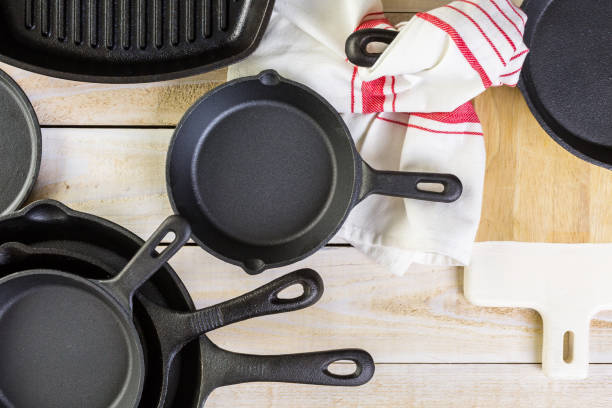
Frequently Asked Questions (FAQs) – Why Is My Cast Iron Pan Sticky After Seasoning
What causes stickiness after seasoning my cast iron pan?
Sticky residue can occur due to excess oil not properly absorbed during the seasoning process. Understanding the right oil amount is crucial for a non-sticky finish.
How can I fix the stickiness of my cast iron pan post-seasoning?
A simple solution is to re-season your pan. Applying a thin layer of oil and baking it in the oven at the appropriate temperature can help achieve a smooth, non-stick surface.
Is there a specific oil type that can prevent stickiness in cast iron seasoning?
Yes, using oils with high smoke points like flaxseed, grapeseed, or avocado oil can create a durable seasoning layer without leaving a sticky residue.
Could uneven seasoning be the reason for stickiness?
Absolutely. Uneven seasoning can result in sticky patches. Ensuring thorough coating and even distribution of oil across the pan’s surface can prevent this issue.
Are there any common mistakes I should avoid during the seasoning process to prevent stickiness?
Over-applying oil, not heating the pan adequately before seasoning, or not allowing enough time for the seasoning layers to polymerize can all lead to a sticky finish. Patience and precision are key.
Can I use my sticky cast iron pan, or is it necessary to fix it immediately?
While it’s not harmful to use a sticky pan, it may lead to food sticking and uneven cooking. Taking the time to address the stickiness will enhance your cooking experience with the cast iron.
How many seasoning layers are typically needed to achieve a non-stick finish?
It varies, but applying multiple thin layers of oil and baking between each layer is a common method. Usually, three to four layers are sufficient to build a solid seasoning base.
Does the humidity or temperature of my kitchen affect the outcome of the seasoning process?
Yes, high humidity can hinder the drying process of the oil, leading to a sticky finish. Ensuring a dry environment and proper ventilation during seasoning can help mitigate this issue.
Is it possible to remove excess oil buildup from my cast iron pan without damaging the seasoning?
Yes, wiping the pan with a paper towel or cloth after seasoning can remove any excess oil before baking. This helps prevent sticky residue while maintaining the integrity of the seasoning.
Can I prevent stickiness in future seasoning attempts?
Absolutely. Learning from each seasoning experience and adjusting factors such as oil amount, heating time, and application technique can refine your process and lead to consistently non-stick results.
Conclusion
In conclusion, the stickiness experienced with a cast iron pan after seasoning can result from various factors, including insufficiently removed excess oil, improper seasoning technique, or seasoning at too high a temperature.
However, with patience, proper cleaning, and additional seasoning cycles if necessary, the stickiness can be remedied. By following best practices in seasoning and maintenance, such as thorough drying and storage in a dry environment, cast iron pans can develop a reliable non-stick surface that enhances cooking experiences for years to come.
Remember, mastering the seasoning process is key to unlocking the full potential of your cast iron cookware and ensuring its longevity and performance in the kitchen.